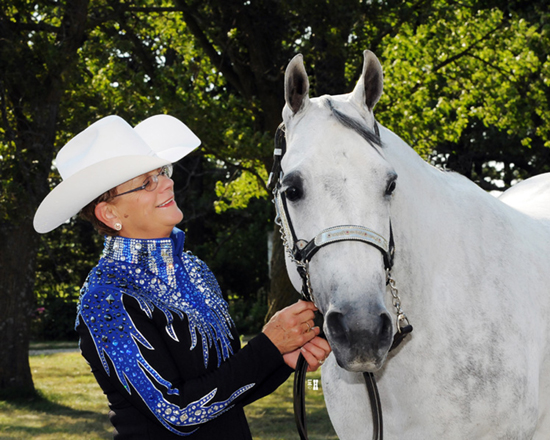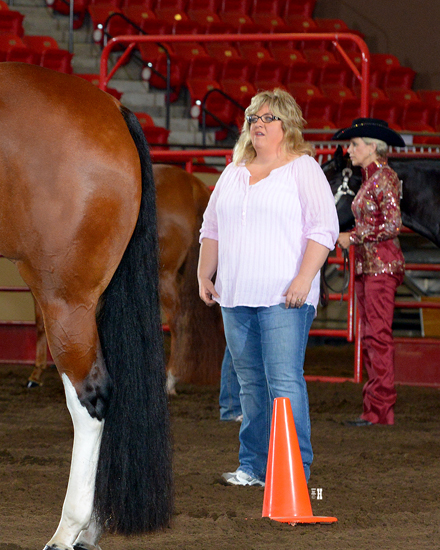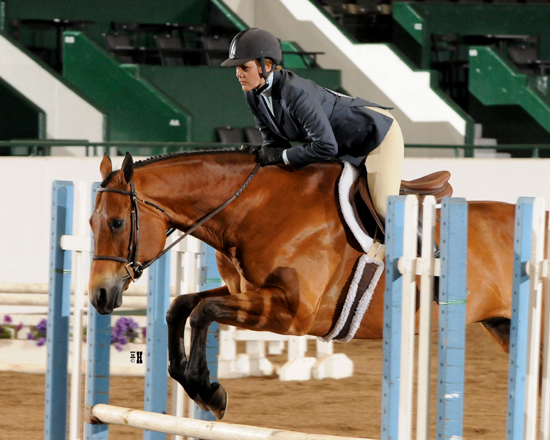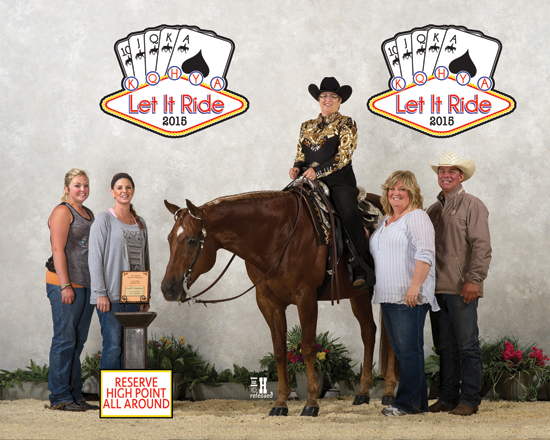
Judy Perry
“I thought I’d killed Judy,” said AQHA Professional Horseman, John Konecne, of Greenfield, Iowa.
Konecne was recalling a few years ago, when he first realized that Select exhibitors might benefit from a change in his thinking as their trainer and coach. He was schooling Judy Perry, one of his Amateur Select clients, and her mare in Showmanship.
“We were working on trotting an L and stopping at the judge for setup.” A self-admitted perfectionist, Konecne was sending Perry back to keep practicing the maneuver multiple times. “She trotted up to me that last time and she was huffing and puffing and trying to catch her breath.”
“Before that, I hadn’t considered the thought that physical activities might become difficult just because of aging,” Konecne said. “Especially my customers who have been with me for several years; you just don’t think about them getting older and maybe things aren’t as easy for them as they once were. Until I got to that select age (50) and it started to sink in when I found there were some things that didn’t come as easily to me as they once had.” Simply the change in the calendar eventually affects physical condition and abilities and limitations become a factor.
Perry, has been showing with Konecne for years in the Amateur western all-around events. The years have developed a comfortable relationship where they both understand the expectations, and now the limitations. “I don’t really get sore from riding, I guess
I’ve ridden enough and I ride a lot, but if I’ve been off for a couple of months and go for a lesson I tell John ‘Please don’t kill me, I want to be able to walk tomorrow.’” His response? “No excuses, let’s get to work.”
“John does group lessons in Showmanship a lot. When he doesn’t keep me repeating the maneuvers, I don’t know if he’s given up on me or if he thinks I’m good enough,” she laughs.
Perry is dedicated to keeping herself in good physical condition, using an elliptical to exerciser regularly.

Leigh Berryhill Coaching
“I have to stay at that just to keep my wind for Showmanship,” she said. “The patterns we are seeing are getting more strenuous, with a lot of trotting. And I refuse to say I can’t do this anymore.”
“It happened to me at a show in Lincoln (Nebraska) not too long ago. We were doing back-to-back patterns for multiple judges. So immediately after showing to the first set of judges we went right to the next pattern without a break. I trotted up to that judge and was just flat out of air. It can happen at our age,” Perry said. “We joke about the geriatrics and that we should require an oxygen tank between patterns, a life alert around our necks and a wheelchair available when we are showing. But it’s not so funny when it happens. We laugh about it among ourselves, and we have to. But really we’re just all so glad to be able to do it.”
The AQHA Select World is such a fun show for the exhibitors of the same sense of humor to aging and the true enjoyment of riding and showing horses. “It’s competitive without being cut-throat,” Perry said.
While Perry has some favorite shows, she says she doesn’t really pick and choose depending on the show or judge. “If we can go, we go,” she explained. The Quarter Horse Congress, Sun Circuit, American Royal and, of course, the Select World top her list of favorites, along with the shows close to home in Des Moines and Lincoln.
“The Minnesota shows are all really friendly,” she said. “And I like Gordyville, unless it snows. It’s hard to pick a favorite.”
Showing has changed for Perry over the years.
“It’s harder for me to do early mornings or late nights,” she said. “I have to work harder sometimes to lift my saddle, it’s harder to keep those muscles strong. My balance seems not as good as it used to be. And I’ve learned I can’t go without food during a long show day so I pay much more attention to proper nutrition.”
Perry has just purchased a new show horse, Willys Good Ride so there’s a lot of work to do.
“I’m trying to get acquainted with her and her with me,” she said. “It takes a bit to learn their personality. So I have a second horse that I take Trail lessons on, to give me the practice, I need, without drilling my show horse beyond what she needs.”

Lori Bucholz
So what about focus?
“Select exhibitors may not seem as focused as the younger riders, but it’s because we have much more life to think about and not just ourselves, grades or boyfriends. We have kids, grandkids, businesses. And we don’t have show parents pushing us from the sidelines,” Perry said. “Maybe I’m less concerned about the results versus the activity. I’m competing with myself each time. I just love doing it.”
Don’t get her wrong – the prize is still great.
“But I feel more like I’m competing with myself. I want to continue to learn and improve all of the time,” she explained.
Konecne thinks the Select Amateur competitors want the win even more.
“It might be that they see a shortened timeline – and they don’t want to run out of time – compared to the twenty-something Amateur who doesn’t see their years showing as limited by a calendar,” he said.
Leigh and Leonard Berryhill operate a successful all around training business in Talala, Oklahoma, primarily producing Open and Amateur, including Select, horses.
“When I first started working as a trainer, I didn’t want to train or coach anyone older than I was, maybe because I was pretty young,” Leigh recalled. “I only wanted to work with youth kids, I didn’t want to boss anyone around who was older than I was.”
It could have been a “respect your elders’ thing.”
“My, how that has changed!” she laughed. “Now I really enjoy teaching Amateurs and especially the Select exhibitors.”
The biggest difference Leigh sees in Select Amateurs from the younger set of Amateurs and Youth is the difference in what’s important to them. The Select Amateurs have lived life.
“They want to show, and be competitive, and do their best, but it’s more about doing better for themselves and achieving personal goals and not the achievement goals of a particular prize.”
Berryhill believes that Select and Youth exhibitors do share one major thing in common.
“In their brain, they have a deadline,” she explained. “The calendar imposes a schedule on their goals. The Youth are trying to get to their goals before they turn 18; the Selects are trying to get to their goals before they get old. The 20-something and 30-something Amateurs are just coasting along, until they hit that magical age of 50.”
For Berryhill , one thing is for certain.
“This is the only place you will find people excited to turn 50,” she said. “I remember my first Select World Show, we had just been at the Youth World, where it’s a killer competition atmosphere. They (competitors)don’t talk to each other. They’re all very serious about the competition and who they are showing against. We get to the Select World, and the exhibitors were all so friendly to each other – ‘I like your jacket,’ wishing each other luck and actually cheering others on. They were so nice to each other!”

Sara Linnes
Another big difference in training Select Amateurs – you don’t have the horse show parents issue.
“That’s not said with malice,” Leigh said. “I’m a mom, and I was a horse show mom of a youth, so I understand all of it. You want your kids to go out and do their best, and you want them to win. But as the trainer, your job is the learning experience in addition to the results.”
Berryhill said she believes the mental side of riding and competing may be more important with Select exhibitors.
“They’re not doing it because their parents want them to show,” she explained. “Youth seem to compete against a certain exhibitor, or to win a certain prize. The Selects are riding and showing because they enjoy it and want to do it.”
Berryhill doesn’t see age-related physical obstacles in her clients that some might expect.
“It seems like today, people are keeping themselves in good shape more than maybe they used to, they are more active in their lives,” she said. “I see more of an issue with just physical limitations – like being short. There’s nothing to do with age there.”
Berryhill shares a story of one of their Amateur Select exhibitors, Sara Linnes, who broadened the trainer’s thought process.
“Sara bought a new horse, and that horse was trained in Showmanship,” she explained. “However, Sara had not done Showmanship. We were at her first show with her new horse – the Sun Circuit, and she wants to do Showmanship. We schedule a time and meet for a lesson. I tell Sara to walk up to me (as the judge) and set up. Sara walks directly to me, stops, stands and looks at me. I wait for her to present her horse; she waits for me to tell her what to do.”
Sara didn’t know the first thing about showing in Showmanship, other than her new horse did it so she wanted to show in it – the next day.
“So, we practiced and practiced, starting at the very beginning,” Berryhill said. “I told her to google Showmanship and she diligently looked up videos online and studied them. She was interested in trying something new and doing it for fun, and she was willing to put in the time and practice to learn. And I find it’s easier to be patient with our select exhibitors.”
Even at the larger shows, the schedule and practice times don’t seem to be an issue for their select customers.
“It’s actually easier than working with the youngerYouth,” Berryhill said. “The kids really do have that internal schedule on eating and sleeping. Selects are like… grab a cup of coffee and let’s roll!”
As a trainer, Berryhill enjoys the preparation with their Amateur Select exhibitors.
“Yes, we want them to win,” she said. “But we also want them to enjoy the steps to it. I do know that everything I thought (when I was younger) how training Amateur Select exhibitors would be is not how it really is. Maybe I just have good ones.”


You must be logged in to post a comment Login